University Finance Module: Corporate Governance Assessment Solution
VerifiedAdded on 2020/03/16
|16
|3681
|267
Homework Assignment
AI Summary
This document presents a comprehensive solution to a corporate governance assessment, addressing key concepts and principles within the finance domain. The solution encompasses definitions of corporate governance, internal control, and the roles of internal auditors. It explores accountability, the functions of the Auditing and Assurance Standards Board, and the Australian Auditing Standards. Furthermore, it examines the roles of ASX and ASIC, alongside the "Corporate Governance Principles and Recommendations." The document also addresses the importance of internal control in combating fraud, organizational policies, and procedures related to corporate governance, and the requirements of RG 64. The solution extends to ethical considerations, including reasons for unethical behavior, confidentiality in handling records, and the basic elements of corporate governance. The document includes a discussion on the role of government in maintaining good corporate governance and relevant financial legislations, and it also includes a case study of Qantas and its corporate governance practices. The document is a valuable resource for students studying corporate governance in finance.

Answer to Assessment 1:
Q1. Definition of “Corporate Governance”
Corporate Governance indicates the manner anorganization is administered. Again, it is the
mechanism by which corporations are directed as well ashandled. Essentially, it
indicatesundertaking the business according to the desires of stakeholders’. Fundamentally, it
is necessarilyundertaken by the board and the concerned committee for the corporation’s
stakeholder.
Q2. Internal Control
Internal control is a procedure for assuring attainment of acorporation’sintents in
functional efficiency, dependable financial reporting, and conformity with regulations,
regulations as well asstrategies. An intensive concept, internal control engages everything
that manages risks to acorporation.
Identification and explanation of the key principles of internal control and auditing
The Main Principles of internal control include:
- Establishment of Responsibilities
- Maintenance of records
- Insurance of Assets by maintaining important employees
- Segregation of different duties
- Mandatory employee rotation
- Split Associated Party Accountability
- Using Technological Controls
- Performance of regular independent reviews
Q1. Definition of “Corporate Governance”
Corporate Governance indicates the manner anorganization is administered. Again, it is the
mechanism by which corporations are directed as well ashandled. Essentially, it
indicatesundertaking the business according to the desires of stakeholders’. Fundamentally, it
is necessarilyundertaken by the board and the concerned committee for the corporation’s
stakeholder.
Q2. Internal Control
Internal control is a procedure for assuring attainment of acorporation’sintents in
functional efficiency, dependable financial reporting, and conformity with regulations,
regulations as well asstrategies. An intensive concept, internal control engages everything
that manages risks to acorporation.
Identification and explanation of the key principles of internal control and auditing
The Main Principles of internal control include:
- Establishment of Responsibilities
- Maintenance of records
- Insurance of Assets by maintaining important employees
- Segregation of different duties
- Mandatory employee rotation
- Split Associated Party Accountability
- Using Technological Controls
- Performance of regular independent reviews
Paraphrase This Document
Need a fresh take? Get an instant paraphrase of this document with our AI Paraphraser
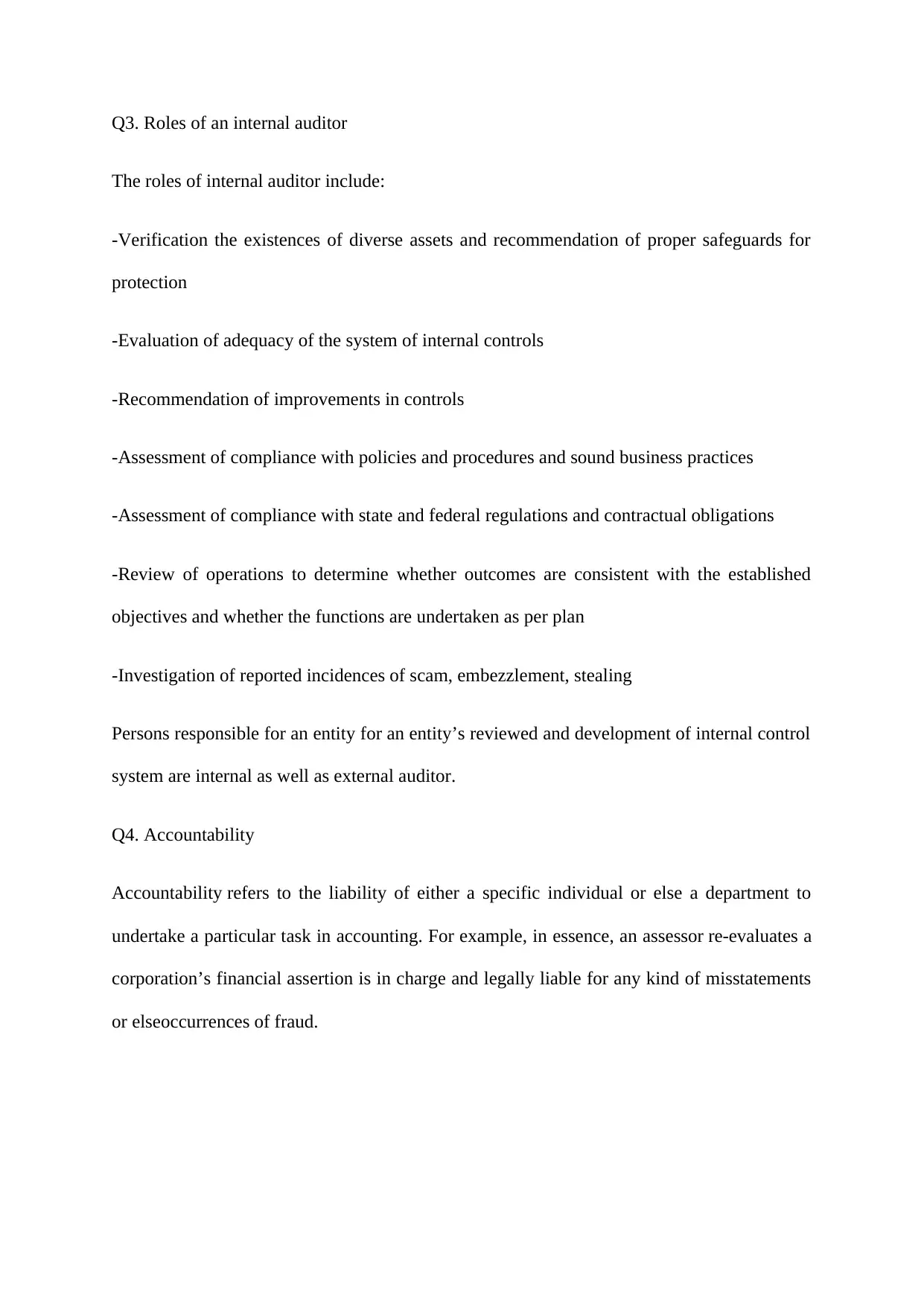
Q3. Roles of an internal auditor
The roles of internal auditor include:
-Verification the existences of diverse assets and recommendation of proper safeguards for
protection
-Evaluation of adequacy of the system of internal controls
-Recommendation of improvements in controls
-Assessment of compliance with policies and procedures and sound business practices
-Assessment of compliance with state and federal regulations and contractual obligations
-Review of operations to determine whether outcomes are consistent with the established
objectives and whether the functions are undertaken as per plan
-Investigation of reported incidences of scam, embezzlement, stealing
Persons responsible for an entity for an entity’s reviewed and development of internal control
system are internal as well as external auditor.
Q4. Accountability
Accountability refers to the liability of either a specific individual or else a department to
undertake a particular task in accounting. For example, in essence, an assessor re-evaluates a
corporation’s financial assertion is in charge and legally liable for any kind of misstatements
or elseoccurrences of fraud.
The roles of internal auditor include:
-Verification the existences of diverse assets and recommendation of proper safeguards for
protection
-Evaluation of adequacy of the system of internal controls
-Recommendation of improvements in controls
-Assessment of compliance with policies and procedures and sound business practices
-Assessment of compliance with state and federal regulations and contractual obligations
-Review of operations to determine whether outcomes are consistent with the established
objectives and whether the functions are undertaken as per plan
-Investigation of reported incidences of scam, embezzlement, stealing
Persons responsible for an entity for an entity’s reviewed and development of internal control
system are internal as well as external auditor.
Q4. Accountability
Accountability refers to the liability of either a specific individual or else a department to
undertake a particular task in accounting. For example, in essence, an assessor re-evaluates a
corporation’s financial assertion is in charge and legally liable for any kind of misstatements
or elseoccurrences of fraud.
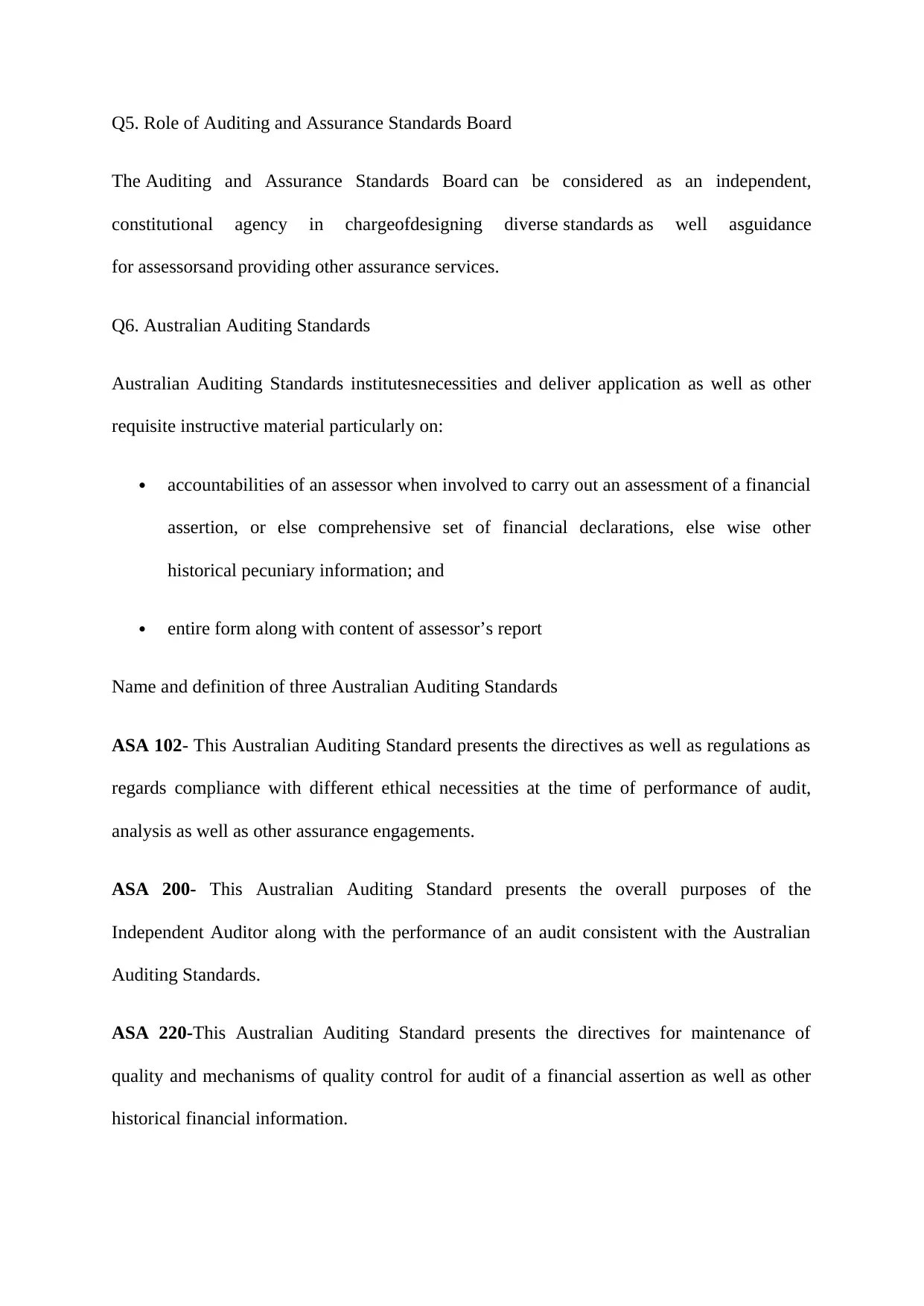
Q5. Role of Auditing and Assurance Standards Board
The Auditing and Assurance Standards Board can be considered as an independent,
constitutional agency in chargeofdesigning diverse standards as well asguidance
for assessorsand providing other assurance services.
Q6. Australian Auditing Standards
Australian Auditing Standards institutesnecessities and deliver application as well as other
requisite instructive material particularly on:
accountabilities of an assessor when involved to carry out an assessment of a financial
assertion, or else comprehensive set of financial declarations, else wise other
historical pecuniary information; and
entire form along with content of assessor’s report
Name and definition of three Australian Auditing Standards
ASA 102- This Australian Auditing Standard presents the directives as well as regulations as
regards compliance with different ethical necessities at the time of performance of audit,
analysis as well as other assurance engagements.
ASA 200- This Australian Auditing Standard presents the overall purposes of the
Independent Auditor along with the performance of an audit consistent with the Australian
Auditing Standards.
ASA 220-This Australian Auditing Standard presents the directives for maintenance of
quality and mechanisms of quality control for audit of a financial assertion as well as other
historical financial information.
The Auditing and Assurance Standards Board can be considered as an independent,
constitutional agency in chargeofdesigning diverse standards as well asguidance
for assessorsand providing other assurance services.
Q6. Australian Auditing Standards
Australian Auditing Standards institutesnecessities and deliver application as well as other
requisite instructive material particularly on:
accountabilities of an assessor when involved to carry out an assessment of a financial
assertion, or else comprehensive set of financial declarations, else wise other
historical pecuniary information; and
entire form along with content of assessor’s report
Name and definition of three Australian Auditing Standards
ASA 102- This Australian Auditing Standard presents the directives as well as regulations as
regards compliance with different ethical necessities at the time of performance of audit,
analysis as well as other assurance engagements.
ASA 200- This Australian Auditing Standard presents the overall purposes of the
Independent Auditor along with the performance of an audit consistent with the Australian
Auditing Standards.
ASA 220-This Australian Auditing Standard presents the directives for maintenance of
quality and mechanisms of quality control for audit of a financial assertion as well as other
historical financial information.
⊘ This is a preview!⊘
Do you want full access?
Subscribe today to unlock all pages.

Trusted by 1+ million students worldwide

Q7. Roles of ASX
ASX operates as an operator of market, clearing house as well as facilitator of payments
system. Essentially, it also supervises conformation todifferent operating regulations,
endorses corporate governance standards among listed corporations ofAustralia and assists to
edify different retail investors.
Explanation of “The Corporate Governance Principles and Recommendations”
The expression “corporate governance” illustrates the structure of regulations, associations,
systems as well asprocedures within entities and by means of which authority is particularly
exercised and guarded within companies. Fundamentally, good corporate governance
encourages investor confidence that is critical to the capability of business concerns listed on
the ASX to try to acquire capital. However, these principles as well as recommendations
presentsuggested corporate governance exercises for different entities that are listed on the
(Australian Stock Exchange) ASX. As suchfrom the point of view of the Council, these
suggested corporate governance practices are likely to attain good governance results and
meet the sensible expectations of majority offinanciers in most circumstances. The structure
of specific principles as well as recommendations intends to promote essential principles that
include the following:
Q8. Role of ASIC
The role of ASIC involves the following:
- Maintain, assist and enhance the performance of financial system and businesses
- Promote both confident as well as informed participation by financiers and users in
the financial system
- Administers the law effectually and with minimal procedural necessities
ASX operates as an operator of market, clearing house as well as facilitator of payments
system. Essentially, it also supervises conformation todifferent operating regulations,
endorses corporate governance standards among listed corporations ofAustralia and assists to
edify different retail investors.
Explanation of “The Corporate Governance Principles and Recommendations”
The expression “corporate governance” illustrates the structure of regulations, associations,
systems as well asprocedures within entities and by means of which authority is particularly
exercised and guarded within companies. Fundamentally, good corporate governance
encourages investor confidence that is critical to the capability of business concerns listed on
the ASX to try to acquire capital. However, these principles as well as recommendations
presentsuggested corporate governance exercises for different entities that are listed on the
(Australian Stock Exchange) ASX. As suchfrom the point of view of the Council, these
suggested corporate governance practices are likely to attain good governance results and
meet the sensible expectations of majority offinanciers in most circumstances. The structure
of specific principles as well as recommendations intends to promote essential principles that
include the following:
Q8. Role of ASIC
The role of ASIC involves the following:
- Maintain, assist and enhance the performance of financial system and businesses
- Promote both confident as well as informed participation by financiers and users in
the financial system
- Administers the law effectually and with minimal procedural necessities
Paraphrase This Document
Need a fresh take? Get an instant paraphrase of this document with our AI Paraphraser
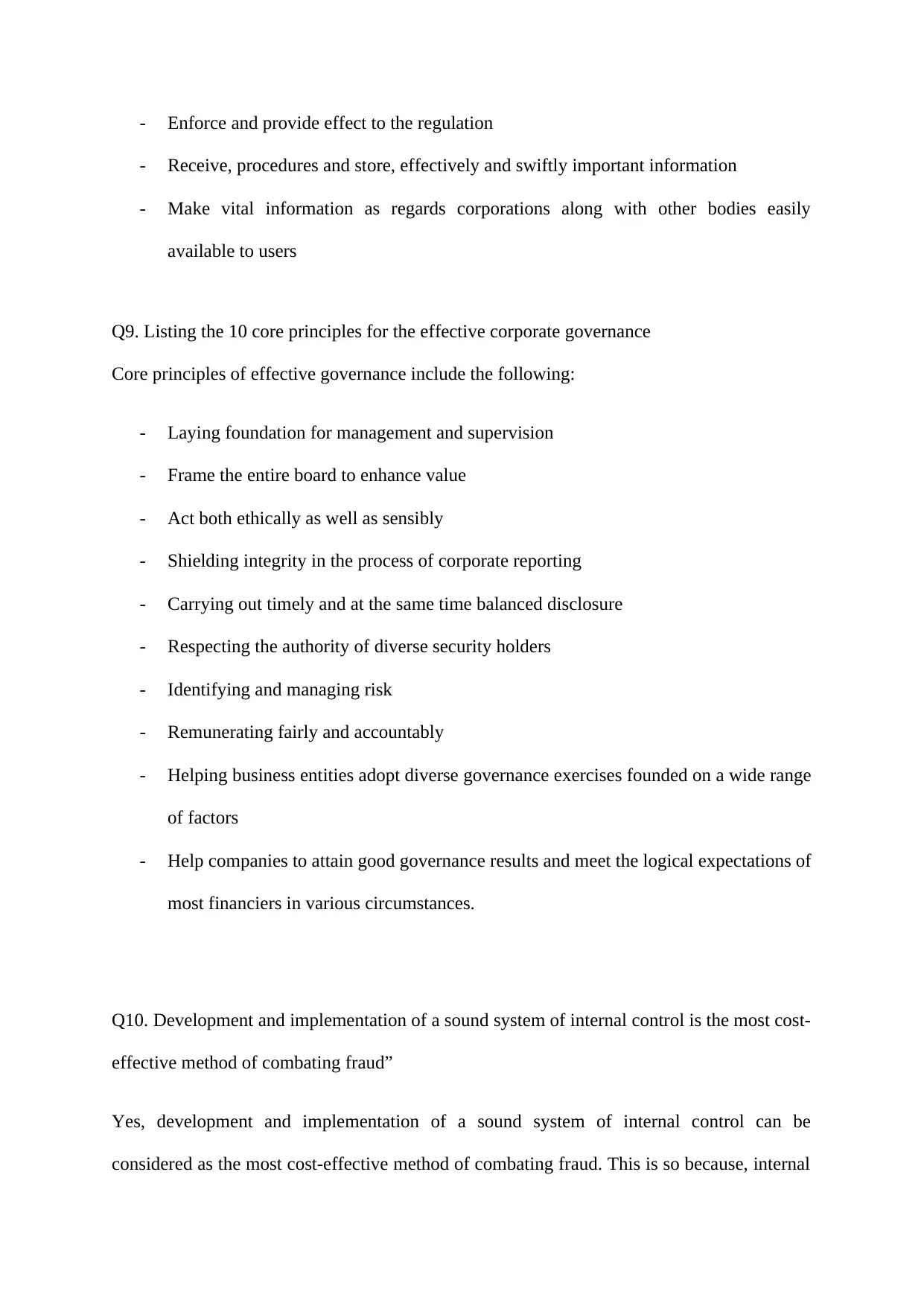
- Enforce and provide effect to the regulation
- Receive, procedures and store, effectively and swiftly important information
- Make vital information as regards corporations along with other bodies easily
available to users
Q9. Listing the 10 core principles for the effective corporate governance
Core principles of effective governance include the following:
- Laying foundation for management and supervision
- Frame the entire board to enhance value
- Act both ethically as well as sensibly
- Shielding integrity in the process of corporate reporting
- Carrying out timely and at the same time balanced disclosure
- Respecting the authority of diverse security holders
- Identifying and managing risk
- Remunerating fairly and accountably
- Helping business entities adopt diverse governance exercises founded on a wide range
of factors
- Help companies to attain good governance results and meet the logical expectations of
most financiers in various circumstances.
Q10. Development and implementation of a sound system of internal control is the most cost-
effective method of combating fraud”
Yes, development and implementation of a sound system of internal control can be
considered as the most cost-effective method of combating fraud. This is so because, internal
- Receive, procedures and store, effectively and swiftly important information
- Make vital information as regards corporations along with other bodies easily
available to users
Q9. Listing the 10 core principles for the effective corporate governance
Core principles of effective governance include the following:
- Laying foundation for management and supervision
- Frame the entire board to enhance value
- Act both ethically as well as sensibly
- Shielding integrity in the process of corporate reporting
- Carrying out timely and at the same time balanced disclosure
- Respecting the authority of diverse security holders
- Identifying and managing risk
- Remunerating fairly and accountably
- Helping business entities adopt diverse governance exercises founded on a wide range
of factors
- Help companies to attain good governance results and meet the logical expectations of
most financiers in various circumstances.
Q10. Development and implementation of a sound system of internal control is the most cost-
effective method of combating fraud”
Yes, development and implementation of a sound system of internal control can be
considered as the most cost-effective method of combating fraud. This is so because, internal
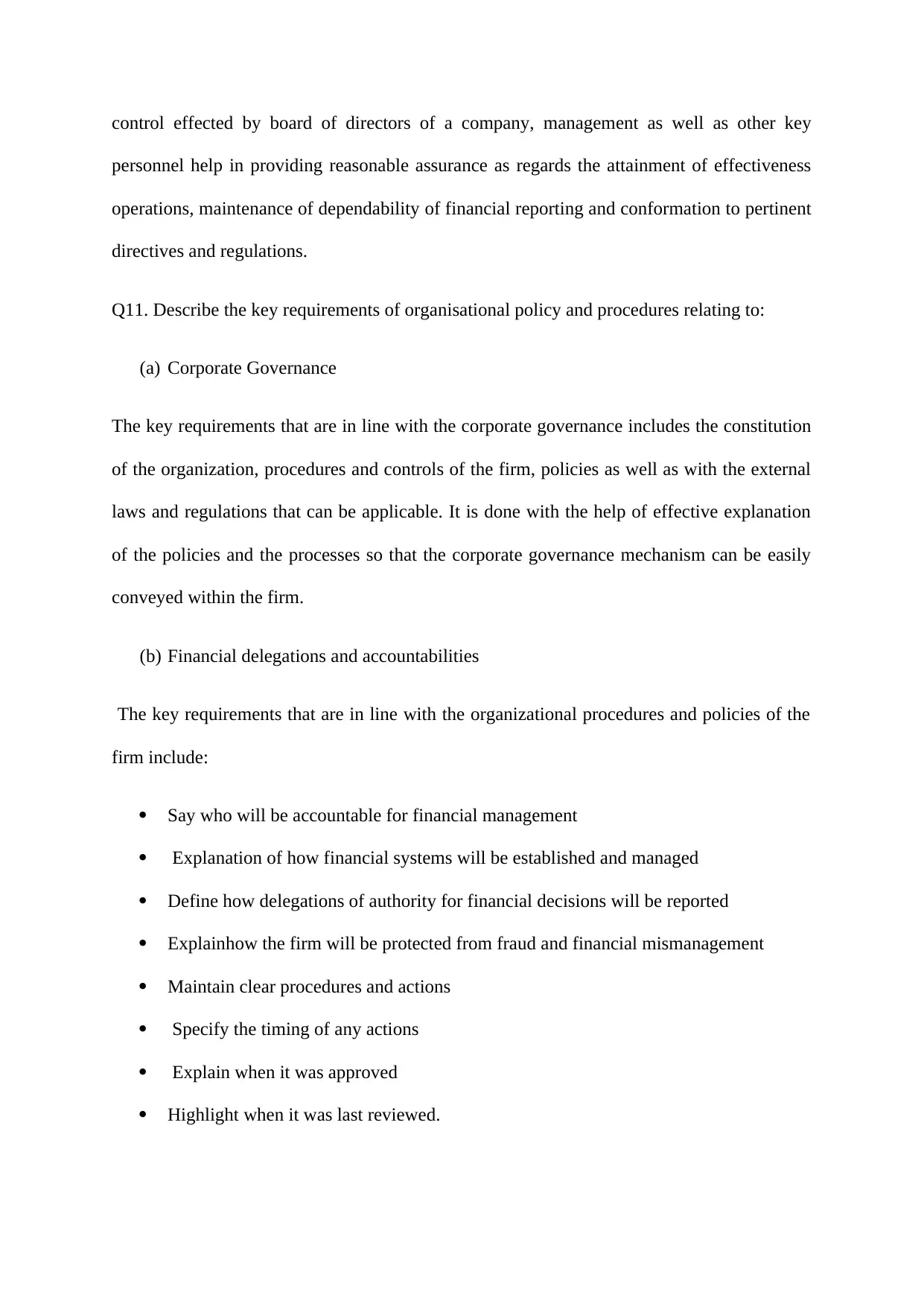
control effected by board of directors of a company, management as well as other key
personnel help in providing reasonable assurance as regards the attainment of effectiveness
operations, maintenance of dependability of financial reporting and conformation to pertinent
directives and regulations.
Q11. Describe the key requirements of organisational policy and procedures relating to:
(a) Corporate Governance
The key requirements that are in line with the corporate governance includes the constitution
of the organization, procedures and controls of the firm, policies as well as with the external
laws and regulations that can be applicable. It is done with the help of effective explanation
of the policies and the processes so that the corporate governance mechanism can be easily
conveyed within the firm.
(b) Financial delegations and accountabilities
The key requirements that are in line with the organizational procedures and policies of the
firm include:
Say who will be accountable for financial management
Explanation of how financial systems will be established and managed
Define how delegations of authority for financial decisions will be reported
Explainhow the firm will be protected from fraud and financial mismanagement
Maintain clear procedures and actions
Specify the timing of any actions
Explain when it was approved
Highlight when it was last reviewed.
personnel help in providing reasonable assurance as regards the attainment of effectiveness
operations, maintenance of dependability of financial reporting and conformation to pertinent
directives and regulations.
Q11. Describe the key requirements of organisational policy and procedures relating to:
(a) Corporate Governance
The key requirements that are in line with the corporate governance includes the constitution
of the organization, procedures and controls of the firm, policies as well as with the external
laws and regulations that can be applicable. It is done with the help of effective explanation
of the policies and the processes so that the corporate governance mechanism can be easily
conveyed within the firm.
(b) Financial delegations and accountabilities
The key requirements that are in line with the organizational procedures and policies of the
firm include:
Say who will be accountable for financial management
Explanation of how financial systems will be established and managed
Define how delegations of authority for financial decisions will be reported
Explainhow the firm will be protected from fraud and financial mismanagement
Maintain clear procedures and actions
Specify the timing of any actions
Explain when it was approved
Highlight when it was last reviewed.
⊘ This is a preview!⊘
Do you want full access?
Subscribe today to unlock all pages.

Trusted by 1+ million students worldwide

Q12. RG 64 Failure to lodge documents
This section initially explains what the organization will do if they fail to lodge the
documents. In this aspect the law imposes on the company secretaries specific
accountabilities for the lodgement of the annual returns, any announcement of
transformations to the officeholders and the registered office of the organization.
In this aspect the summary of the proceedings along with deregistration, reinstatement are
even explained. In this aspect the six monthly returns from the external administrators, the
foreign company accounts and the additional actions are stated down.
The underlying principles with respect to RG 64.10 are explained where the explanations,
deregistration are stated forward.
The next step of the failure to lodge the documents explains the time of the withdrawal of the
proceedings against a company secretary and in this aspect the policies in relation to the
annual returns are explained in line with the sections of RG 64. The process to apply for the
withdrawal proceedings are even put forward so that the organizations can have a clear idea
about the process that would be effective for the failure for lodging of the document. The
associated information with respect to this topic is even put forward so that effective idea can
be attained.
Assessment 2
This section of the paper discusses about the principles that have been learnt during
the course and it is seen that corporate governance has been found to be one of the significant
issues that are in consideration by most of the organizations that have been functioning all
over the globe. It is seen that Qantas is one of the renowned airline companies that have been
operating in Australia and various other countries. Corporate governance involves balancing
This section initially explains what the organization will do if they fail to lodge the
documents. In this aspect the law imposes on the company secretaries specific
accountabilities for the lodgement of the annual returns, any announcement of
transformations to the officeholders and the registered office of the organization.
In this aspect the summary of the proceedings along with deregistration, reinstatement are
even explained. In this aspect the six monthly returns from the external administrators, the
foreign company accounts and the additional actions are stated down.
The underlying principles with respect to RG 64.10 are explained where the explanations,
deregistration are stated forward.
The next step of the failure to lodge the documents explains the time of the withdrawal of the
proceedings against a company secretary and in this aspect the policies in relation to the
annual returns are explained in line with the sections of RG 64. The process to apply for the
withdrawal proceedings are even put forward so that the organizations can have a clear idea
about the process that would be effective for the failure for lodging of the document. The
associated information with respect to this topic is even put forward so that effective idea can
be attained.
Assessment 2
This section of the paper discusses about the principles that have been learnt during
the course and it is seen that corporate governance has been found to be one of the significant
issues that are in consideration by most of the organizations that have been functioning all
over the globe. It is seen that Qantas is one of the renowned airline companies that have been
operating in Australia and various other countries. Corporate governance involves balancing
Paraphrase This Document
Need a fresh take? Get an instant paraphrase of this document with our AI Paraphraser
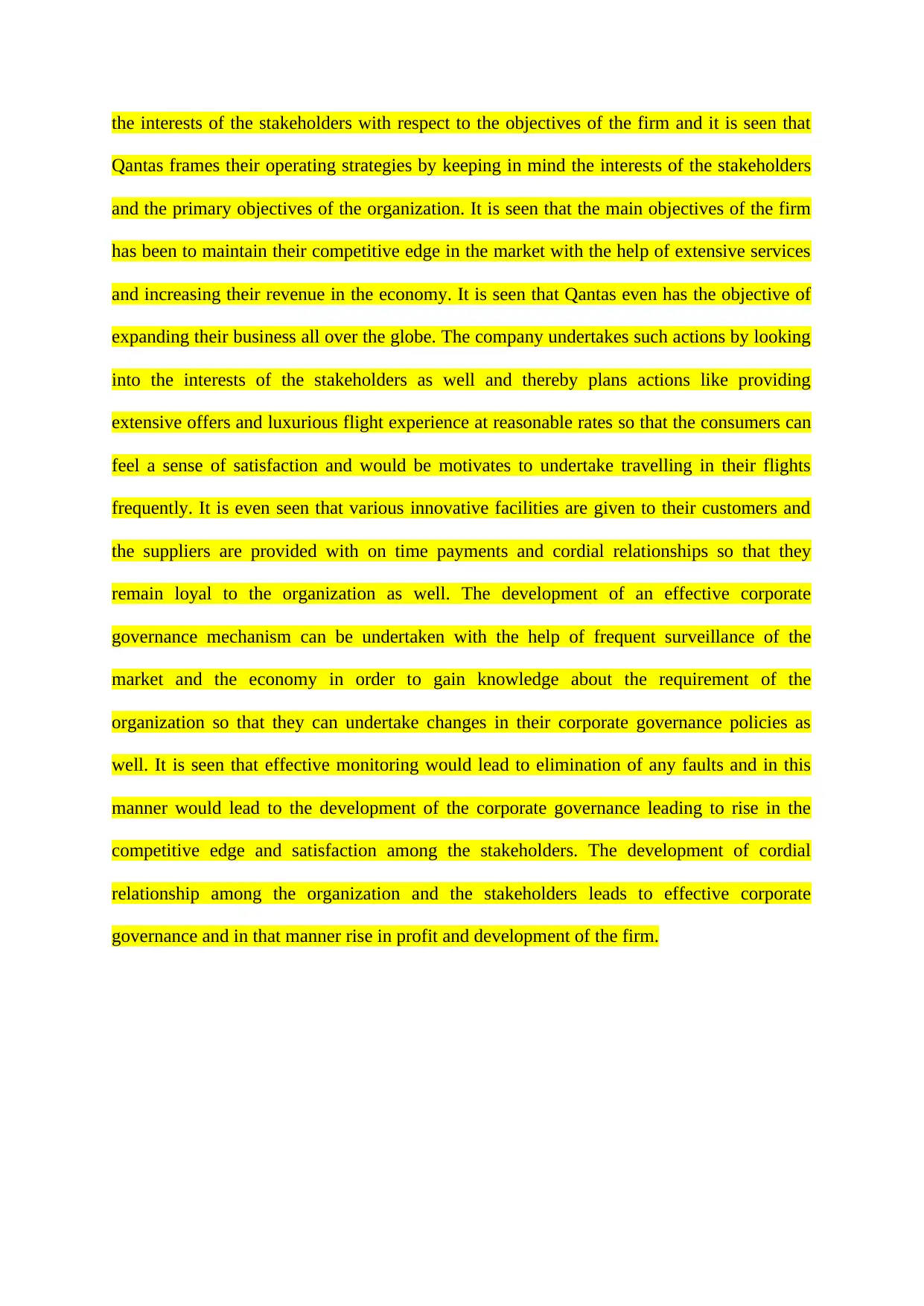
the interests of the stakeholders with respect to the objectives of the firm and it is seen that
Qantas frames their operating strategies by keeping in mind the interests of the stakeholders
and the primary objectives of the organization. It is seen that the main objectives of the firm
has been to maintain their competitive edge in the market with the help of extensive services
and increasing their revenue in the economy. It is seen that Qantas even has the objective of
expanding their business all over the globe. The company undertakes such actions by looking
into the interests of the stakeholders as well and thereby plans actions like providing
extensive offers and luxurious flight experience at reasonable rates so that the consumers can
feel a sense of satisfaction and would be motivates to undertake travelling in their flights
frequently. It is even seen that various innovative facilities are given to their customers and
the suppliers are provided with on time payments and cordial relationships so that they
remain loyal to the organization as well. The development of an effective corporate
governance mechanism can be undertaken with the help of frequent surveillance of the
market and the economy in order to gain knowledge about the requirement of the
organization so that they can undertake changes in their corporate governance policies as
well. It is seen that effective monitoring would lead to elimination of any faults and in this
manner would lead to the development of the corporate governance leading to rise in the
competitive edge and satisfaction among the stakeholders. The development of cordial
relationship among the organization and the stakeholders leads to effective corporate
governance and in that manner rise in profit and development of the firm.
Qantas frames their operating strategies by keeping in mind the interests of the stakeholders
and the primary objectives of the organization. It is seen that the main objectives of the firm
has been to maintain their competitive edge in the market with the help of extensive services
and increasing their revenue in the economy. It is seen that Qantas even has the objective of
expanding their business all over the globe. The company undertakes such actions by looking
into the interests of the stakeholders as well and thereby plans actions like providing
extensive offers and luxurious flight experience at reasonable rates so that the consumers can
feel a sense of satisfaction and would be motivates to undertake travelling in their flights
frequently. It is even seen that various innovative facilities are given to their customers and
the suppliers are provided with on time payments and cordial relationships so that they
remain loyal to the organization as well. The development of an effective corporate
governance mechanism can be undertaken with the help of frequent surveillance of the
market and the economy in order to gain knowledge about the requirement of the
organization so that they can undertake changes in their corporate governance policies as
well. It is seen that effective monitoring would lead to elimination of any faults and in this
manner would lead to the development of the corporate governance leading to rise in the
competitive edge and satisfaction among the stakeholders. The development of cordial
relationship among the organization and the stakeholders leads to effective corporate
governance and in that manner rise in profit and development of the firm.

Assessment 3
Q1. What are reasons for unethical behaviour? Discuss ethical considerations
andconfidentiality for management and handling of files and records.
The main reasons behind the development of unethical behaviour involve:
Individual factors
Issue-specific factors
Environmental factors
Ethical considerations andconfidentiality for management and handling of files and records
Written records have a solidness and reproducibility that is unique from spoken data; there
are hence extra concerns about the assurance and treatment of paper documents or the
computerised records. These challenges and concerns have turned out to be more
unpredictable and exceptional because of the digitizing of data. Confidentiality breaches can
happen because of the way records are established, transmitted and stored.
Conventionally, experts ought not construct, store records and update on their own electronic
gadgets (e.g., PCs and flash drives) or individual online accounts. In the event that a work
environment knows about and permits such off-site treatment of records, privacy safeguards,
for example, password protection and anonym zed customer identification proof, ought to be
observed meticulously.
All specialists who rehearse independently and all businesses ought to have clear composed
strategies concerning customer records. The work environment policies concerning records
administration ought to normally address.
Record accuracy and content;
Record storage, both electronic and paper;
Q1. What are reasons for unethical behaviour? Discuss ethical considerations
andconfidentiality for management and handling of files and records.
The main reasons behind the development of unethical behaviour involve:
Individual factors
Issue-specific factors
Environmental factors
Ethical considerations andconfidentiality for management and handling of files and records
Written records have a solidness and reproducibility that is unique from spoken data; there
are hence extra concerns about the assurance and treatment of paper documents or the
computerised records. These challenges and concerns have turned out to be more
unpredictable and exceptional because of the digitizing of data. Confidentiality breaches can
happen because of the way records are established, transmitted and stored.
Conventionally, experts ought not construct, store records and update on their own electronic
gadgets (e.g., PCs and flash drives) or individual online accounts. In the event that a work
environment knows about and permits such off-site treatment of records, privacy safeguards,
for example, password protection and anonym zed customer identification proof, ought to be
observed meticulously.
All specialists who rehearse independently and all businesses ought to have clear composed
strategies concerning customer records. The work environment policies concerning records
administration ought to normally address.
Record accuracy and content;
Record storage, both electronic and paper;
⊘ This is a preview!⊘
Do you want full access?
Subscribe today to unlock all pages.

Trusted by 1+ million students worldwide
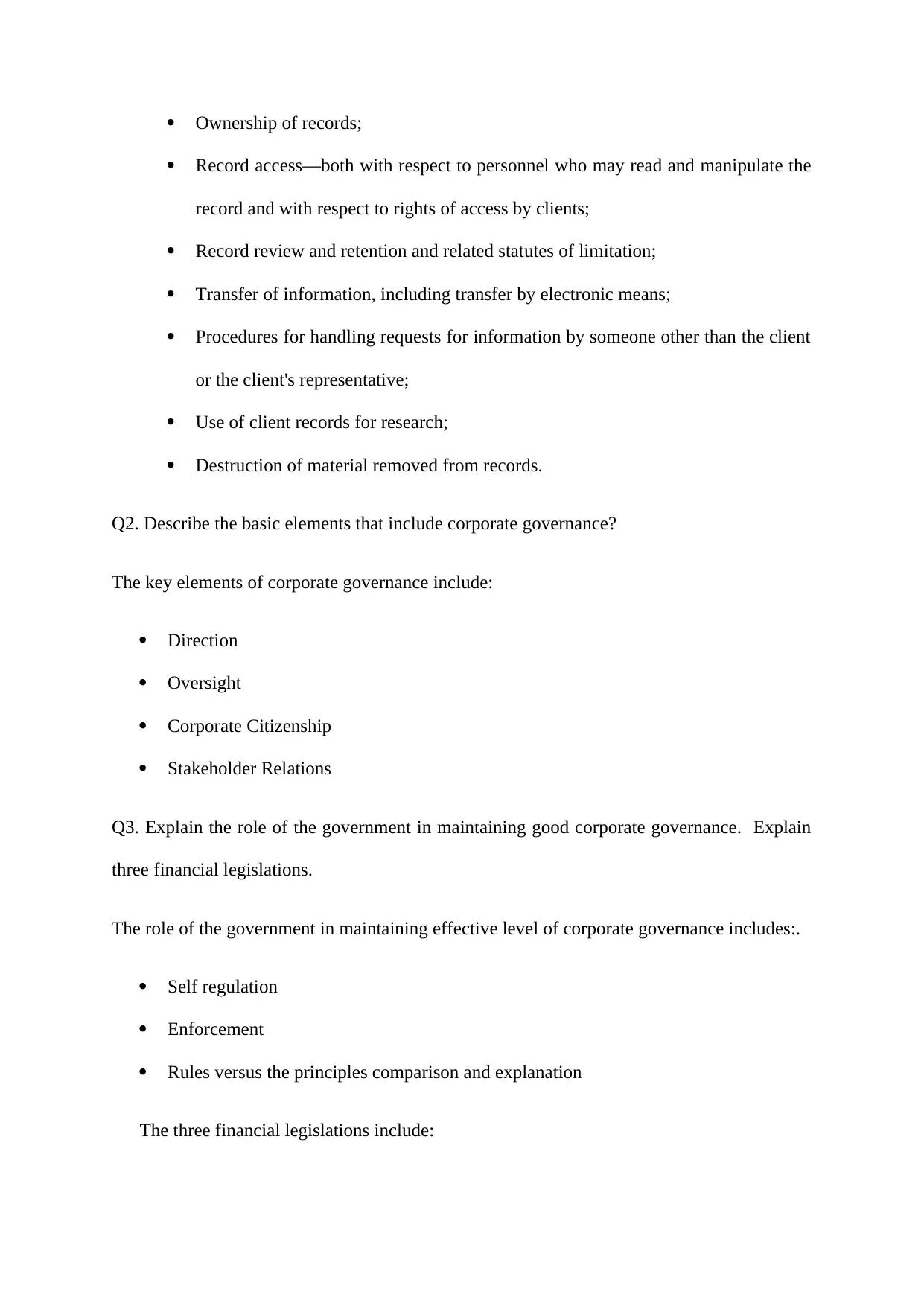
Ownership of records;
Record access—both with respect to personnel who may read and manipulate the
record and with respect to rights of access by clients;
Record review and retention and related statutes of limitation;
Transfer of information, including transfer by electronic means;
Procedures for handling requests for information by someone other than the client
or the client's representative;
Use of client records for research;
Destruction of material removed from records.
Q2. Describe the basic elements that include corporate governance?
The key elements of corporate governance include:
Direction
Oversight
Corporate Citizenship
Stakeholder Relations
Q3. Explain the role of the government in maintaining good corporate governance. Explain
three financial legislations.
The role of the government in maintaining effective level of corporate governance includes:.
Self regulation
Enforcement
Rules versus the principles comparison and explanation
The three financial legislations include:
Record access—both with respect to personnel who may read and manipulate the
record and with respect to rights of access by clients;
Record review and retention and related statutes of limitation;
Transfer of information, including transfer by electronic means;
Procedures for handling requests for information by someone other than the client
or the client's representative;
Use of client records for research;
Destruction of material removed from records.
Q2. Describe the basic elements that include corporate governance?
The key elements of corporate governance include:
Direction
Oversight
Corporate Citizenship
Stakeholder Relations
Q3. Explain the role of the government in maintaining good corporate governance. Explain
three financial legislations.
The role of the government in maintaining effective level of corporate governance includes:.
Self regulation
Enforcement
Rules versus the principles comparison and explanation
The three financial legislations include:
Paraphrase This Document
Need a fresh take? Get an instant paraphrase of this document with our AI Paraphraser
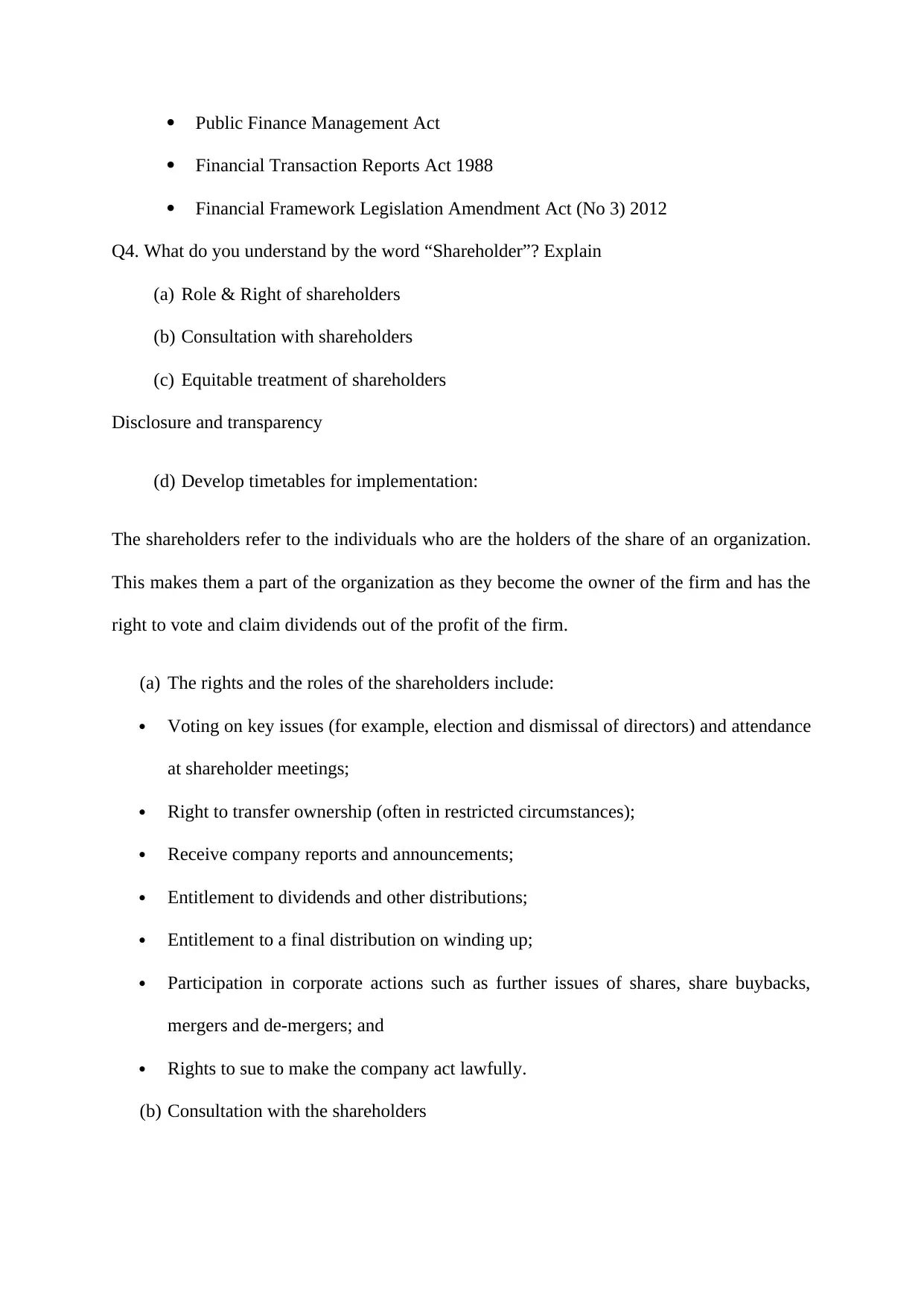
Public Finance Management Act
Financial Transaction Reports Act 1988
Financial Framework Legislation Amendment Act (No 3) 2012
Q4. What do you understand by the word “Shareholder”? Explain
(a) Role & Right of shareholders
(b) Consultation with shareholders
(c) Equitable treatment of shareholders
Disclosure and transparency
(d) Develop timetables for implementation:
The shareholders refer to the individuals who are the holders of the share of an organization.
This makes them a part of the organization as they become the owner of the firm and has the
right to vote and claim dividends out of the profit of the firm.
(a) The rights and the roles of the shareholders include:
Voting on key issues (for example, election and dismissal of directors) and attendance
at shareholder meetings;
Right to transfer ownership (often in restricted circumstances);
Receive company reports and announcements;
Entitlement to dividends and other distributions;
Entitlement to a final distribution on winding up;
Participation in corporate actions such as further issues of shares, share buybacks,
mergers and de-mergers; and
Rights to sue to make the company act lawfully.
(b) Consultation with the shareholders
Financial Transaction Reports Act 1988
Financial Framework Legislation Amendment Act (No 3) 2012
Q4. What do you understand by the word “Shareholder”? Explain
(a) Role & Right of shareholders
(b) Consultation with shareholders
(c) Equitable treatment of shareholders
Disclosure and transparency
(d) Develop timetables for implementation:
The shareholders refer to the individuals who are the holders of the share of an organization.
This makes them a part of the organization as they become the owner of the firm and has the
right to vote and claim dividends out of the profit of the firm.
(a) The rights and the roles of the shareholders include:
Voting on key issues (for example, election and dismissal of directors) and attendance
at shareholder meetings;
Right to transfer ownership (often in restricted circumstances);
Receive company reports and announcements;
Entitlement to dividends and other distributions;
Entitlement to a final distribution on winding up;
Participation in corporate actions such as further issues of shares, share buybacks,
mergers and de-mergers; and
Rights to sue to make the company act lawfully.
(b) Consultation with the shareholders
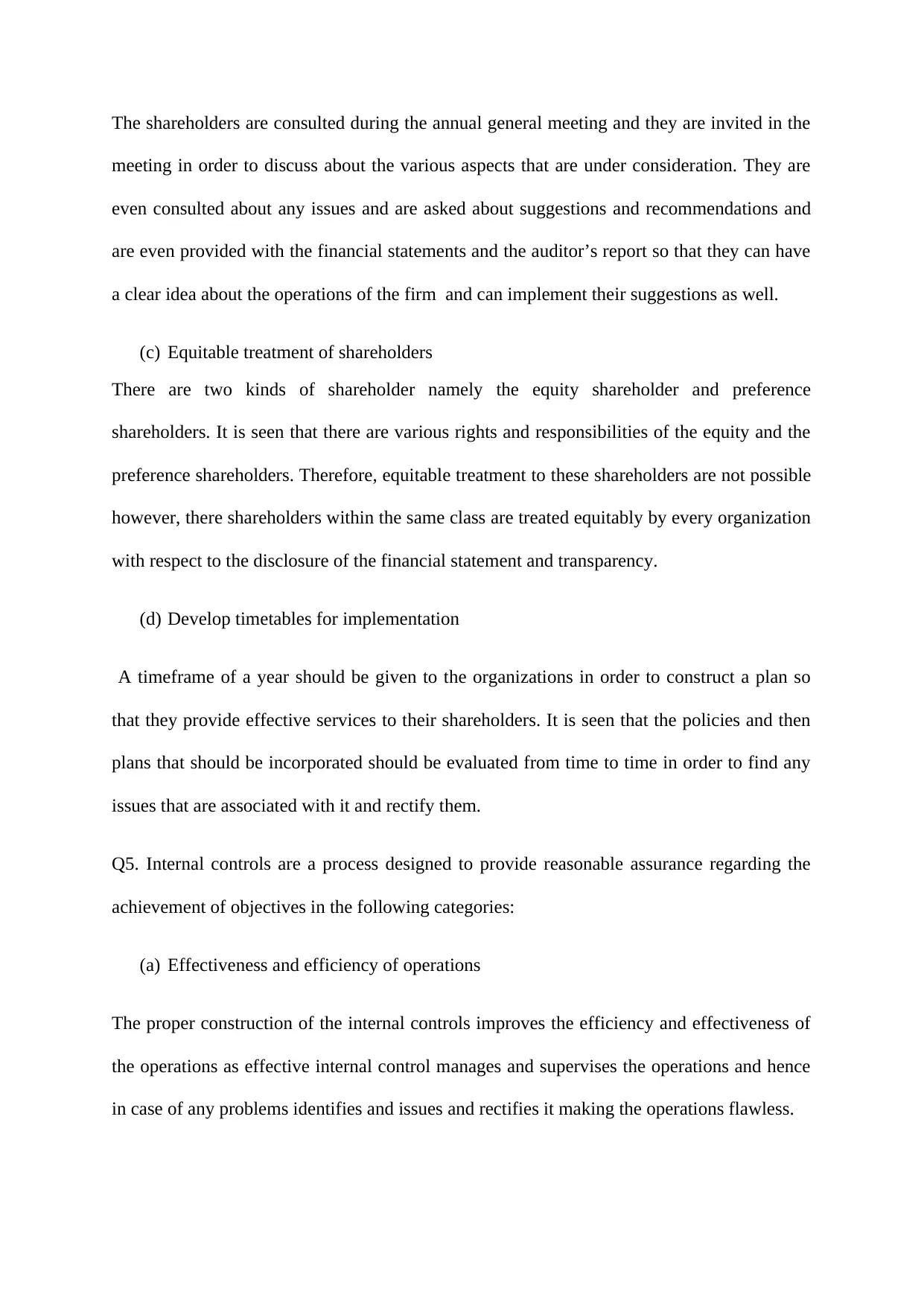
The shareholders are consulted during the annual general meeting and they are invited in the
meeting in order to discuss about the various aspects that are under consideration. They are
even consulted about any issues and are asked about suggestions and recommendations and
are even provided with the financial statements and the auditor’s report so that they can have
a clear idea about the operations of the firm and can implement their suggestions as well.
(c) Equitable treatment of shareholders
There are two kinds of shareholder namely the equity shareholder and preference
shareholders. It is seen that there are various rights and responsibilities of the equity and the
preference shareholders. Therefore, equitable treatment to these shareholders are not possible
however, there shareholders within the same class are treated equitably by every organization
with respect to the disclosure of the financial statement and transparency.
(d) Develop timetables for implementation
A timeframe of a year should be given to the organizations in order to construct a plan so
that they provide effective services to their shareholders. It is seen that the policies and then
plans that should be incorporated should be evaluated from time to time in order to find any
issues that are associated with it and rectify them.
Q5. Internal controls are a process designed to provide reasonable assurance regarding the
achievement of objectives in the following categories:
(a) Effectiveness and efficiency of operations
The proper construction of the internal controls improves the efficiency and effectiveness of
the operations as effective internal control manages and supervises the operations and hence
in case of any problems identifies and issues and rectifies it making the operations flawless.
meeting in order to discuss about the various aspects that are under consideration. They are
even consulted about any issues and are asked about suggestions and recommendations and
are even provided with the financial statements and the auditor’s report so that they can have
a clear idea about the operations of the firm and can implement their suggestions as well.
(c) Equitable treatment of shareholders
There are two kinds of shareholder namely the equity shareholder and preference
shareholders. It is seen that there are various rights and responsibilities of the equity and the
preference shareholders. Therefore, equitable treatment to these shareholders are not possible
however, there shareholders within the same class are treated equitably by every organization
with respect to the disclosure of the financial statement and transparency.
(d) Develop timetables for implementation
A timeframe of a year should be given to the organizations in order to construct a plan so
that they provide effective services to their shareholders. It is seen that the policies and then
plans that should be incorporated should be evaluated from time to time in order to find any
issues that are associated with it and rectify them.
Q5. Internal controls are a process designed to provide reasonable assurance regarding the
achievement of objectives in the following categories:
(a) Effectiveness and efficiency of operations
The proper construction of the internal controls improves the efficiency and effectiveness of
the operations as effective internal control manages and supervises the operations and hence
in case of any problems identifies and issues and rectifies it making the operations flawless.
⊘ This is a preview!⊘
Do you want full access?
Subscribe today to unlock all pages.

Trusted by 1+ million students worldwide
1 out of 16
Related Documents
Your All-in-One AI-Powered Toolkit for Academic Success.
+13062052269
info@desklib.com
Available 24*7 on WhatsApp / Email
![[object Object]](/_next/static/media/star-bottom.7253800d.svg)
Unlock your academic potential
Copyright © 2020–2025 A2Z Services. All Rights Reserved. Developed and managed by ZUCOL.





